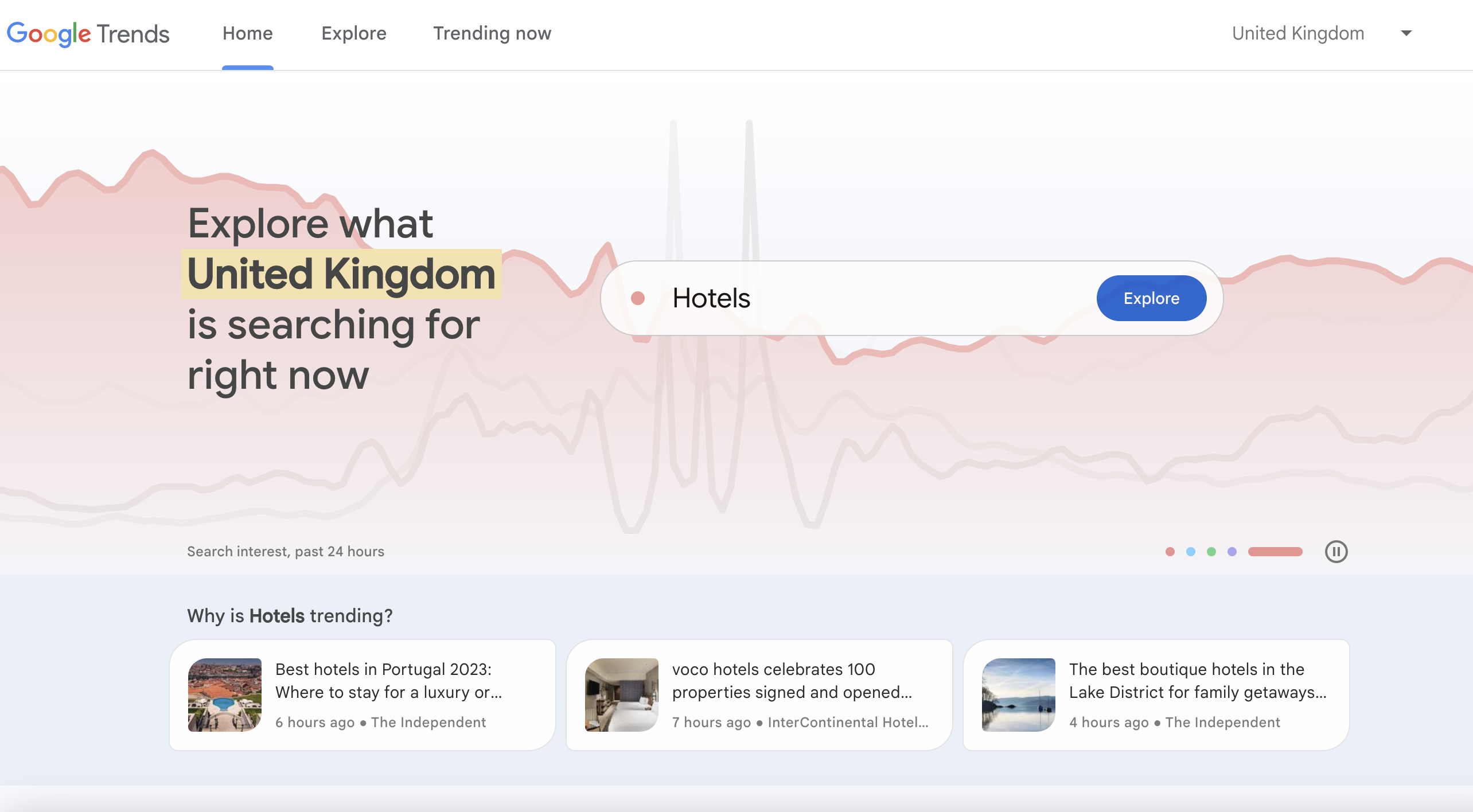Google revealed 7 hidden features in Google Trends that can enhance your data analysis and research capabilities. These features offer deeper insights into search patterns and trends.
Google Trends is an essential tool for marketers, researchers, and content creators. It provides valuable insights into search patterns and user interests. The platform recently unveiled 7 hidden features that can significantly enhance your data analysis. These tools help users gain more precise and comprehensive information.
From geographic comparisons to real-time data and historical data access, these features offer powerful ways to analyze search trends. Using these hidden tools, you can make more informed decisions and stay ahead of market trends. Explore these features to fully leverage the potential of Google Trends.

Credit: www.searchenginejournal.com
Introduction To Google Trends
Google Trends is a powerful tool for discovering search patterns. It helps users understand what people are searching for online. This tool can be a game-changer for content creators and marketers. Below, we explore its features and benefits.
What Is Google Trends?
Google Trends shows search term popularity over time. It provides insights into what people are curious about. You can compare different search terms. It gives you data about trending topics. This tool is free and easy to use. Marketers and researchers often use it for data-driven decisions.
Importance Of Google Trends
Google Trends is crucial for several reasons:
- Understanding Audience Interests: It helps identify what the audience cares about.
- Content Planning: Create content based on trending topics.
- SEO Optimization: Use trending keywords to improve search rankings.
- Market Research: Analyze market trends and consumer behavior.
Using Google Trends effectively can boost your content strategy. It can also improve your marketing efforts. It’s a valuable tool for staying ahead in the digital landscape.
| Feature | Description |
|---|---|
| Real-Time Data | Provides up-to-the-minute search data. |
| Geographical Insights | Shows search data by location. |
| Topic Comparisons | Compare multiple search terms at once. |
These features make Google Trends a versatile tool. It can be used for various research and marketing purposes.
Real-time Data
Google Trends is a powerful tool for marketers and researchers. One of its most exciting features is Real-Time Data. This feature provides up-to-the-minute insights into trending topics. Let’s explore how to access and benefit from this data.
Accessing Real-time Data
Accessing Real-Time Data in Google Trends is simple. Follow these steps:
- Go to the Google Trends website.
- Enter a search term or topic in the search bar.
- Select the “Real-Time” tab to see the latest trends.
- Use filters to narrow down results by region, category, and time.
Benefits Of Real-time Data
Real-Time Data offers many advantages for users:
- Stay Updated: Keep up with the latest trends and news.
- Improve Marketing: Tailor campaigns to trending topics.
- Research Insights: Gain valuable data for academic research.
- Content Creation: Create timely and relevant content.
Using Real-Time Data can significantly enhance your strategy. It helps in making informed decisions quickly.
Geographical Insights
Google Trends offers valuable geographical insights to understand how search interests vary across different regions. These insights can help businesses, researchers, and marketers make data-driven decisions.
Locating Trends By Region
With Google Trends, you can easily locate trends by region. This feature allows you to see where specific search terms are most popular.
For example, if you search for “soccer,” you might see higher interest in countries like Brazil and Spain. This can help you tailor content and marketing strategies for specific locations.
Using Regional Data
Using regional data from Google Trends can provide a wealth of information. Here are some ways you can use this data:
- Identify market opportunities: Discover regions with growing interest in your product or service.
- Understand cultural trends: See how cultural events influence search behavior in different areas.
- Optimize local SEO: Tailor your keywords to match regional search trends.
Here is a simple example table to illustrate the popularity of a search term in different regions:
| Region | Search Interest |
|---|---|
| United States | 75 |
| India | 80 |
| Germany | 65 |
Understanding these insights can significantly enhance your marketing efforts. Make sure to use Google Trends’ geographical data to stay ahead of the competition.
Comparative Analysis
Google Trends offers powerful tools for analyzing search trends. One of the most useful features is Comparative Analysis. This allows users to compare multiple search terms over time. This section will explore how to use this feature effectively.
Comparing Multiple Terms
Google Trends lets you compare up to five search terms. This helps in understanding the relative popularity of each term. Use the search box to add different terms.
- Type a search term and hit Enter.
- Click on “Compare” to add another term.
- Repeat until you have added all desired terms.
A color-coded graph will display the results. Each term will have a different color. This makes it easy to compare them visually.
Interpreting Comparative Results
The graph shows the relative search interest over time. The y-axis represents the popularity. The x-axis shows the time period.
Key Points to Note:
- Higher peaks indicate more interest.
- Flat lines suggest stable interest.
- Dips indicate a decrease in interest.
Use the data to make informed decisions. For instance, if planning a marketing campaign, choose the term with the highest interest.
Example:
| Term | Interest Over Time |
|---|---|
| Term A | High during summer |
| Term B | Consistent throughout the year |
This table shows how different terms perform. Use such insights to optimize content and strategies.
Related Queries
Google Trends offers many features. One of the most useful is Related Queries. It helps users discover what others are searching for. This can be very valuable for understanding trends.
Finding Related Queries
To find Related Queries, follow these steps:
- Open Google Trends.
- Enter a search term.
- Scroll down to see Related Queries.
These queries are popular searches related to your term. They can give you insights into what people are interested in. For example, if you search for “chocolate cake,” you might see related queries like “best chocolate cake recipe” or “easy chocolate cake.”
Leveraging Related Queries
Using Related Queries can boost your content strategy. Here are some tips:
- Keyword Optimization: Use these queries to find new keywords for your content.
- Content Ideas: Develop content based on what people are searching for.
- Competitor Analysis: Understand what your competitors might be targeting.
Consider creating a table to track your findings:
| Related Query | Search Volume | Potential Content Ideas |
|---|---|---|
| Best chocolate cake recipe | High | Recipe post with step-by-step photos |
| Easy chocolate cake | Medium | Video tutorial for beginners |
Using these strategies can help improve your SEO. You can create content that matches what people want. This can lead to more traffic and engagement.
Credit: www.google.com
Category Filtering
Google Trends offers a powerful feature called Category Filtering. This feature helps you narrow down your search results. You can focus on specific topics and industries. It makes your data more relevant and precise.
Applying Category Filters
Applying category filters is simple. Follow these steps:
- Open Google Trends.
- Enter your search term.
- Select the “Categories” option.
- Choose a category from the dropdown menu.
This filter helps you find trends within a specific context. It refines your search results.
Benefits Of Category Filters
Category filters offer many benefits:
- Relevance: They make your data more relevant.
- Precision: They narrow down the results.
- Efficiency: They save you time.
By using category filters, you can focus on specific topics. This helps in making better decisions.
Seasonal Trends
Seasonal Trends play a vital role in understanding market dynamics. Google Trends can help marketers identify these patterns effectively. Businesses can plan better by leveraging seasonal data. Let’s dive into how to make the most out of this feature.
Identifying Seasonal Patterns
Google Trends allows users to track seasonal patterns in search behavior. You can see how interest in specific topics varies over time. This helps in understanding the seasonal demand for products or services.
To identify these patterns:
- Go to Google Trends.
- Enter a keyword in the search bar.
- Select the time range you want to analyze.
A graph will display the search interest over time. Look for peaks and valleys to understand the seasonal trends.
Using Seasonal Data
Once you identify seasonal patterns, you can use this data to your advantage. Plan your marketing campaigns around high-demand periods. This ensures maximum visibility and engagement.
Here is how you can use seasonal data:
- Content Planning: Create content that aligns with seasonal trends.
- Inventory Management: Stock up on products that are in high demand.
- Ad Campaigns: Run ads during peak seasons for better ROI.
Using seasonal data can help you stay ahead of competitors. It allows you to meet customer needs effectively.

Credit: newsinitiative.withgoogle.com
Visualizing Trends
Google Trends offers powerful tools to visualize search data. These tools help users understand trends better. Visualizing data makes it easier to spot patterns. Let’s explore how to create and share visual reports in Google Trends.
Creating Visual Reports
Creating visual reports in Google Trends is straightforward. Follow these simple steps:
- Open Google Trends.
- Enter a search term or topic.
- Select the desired time range and region.
- Click on the “Explore” button.
- Use filters to refine your data.
Once you have your data, you can create different types of visualizations:
- Line Graphs: Great for showing trends over time.
- Bar Charts: Useful for comparing different categories.
- Maps: Ideal for geographic data visualization.
Visual reports help you present data clearly. They make it easier to communicate insights to others.
Sharing Trend Visualizations
Sharing trend visualizations is simple. Here’s how to do it:
- After creating your visual report, click on the “Share” button.
- Select the platform where you want to share.
- Copy the link or embed code provided.
- Paste the link or embed code on your desired platform.
You can also download the visualizations as images. This is useful for presentations and reports. To download, click on the “Download” button and choose the format you need.
Sharing visual data helps others understand trends. It makes your insights more impactful.
Frequently Asked Questions
What Are Google Trends Hidden Features?
Google Trends has several hidden features like comparing search terms, exploring trending topics, and analyzing search volume over time.
How To Compare Search Terms In Google Trends?
You can compare search terms by entering multiple queries separated by commas. This helps in analyzing relative popularity.
Can Google Trends Show Trending Topics?
Yes, Google Trends displays trending topics. You can explore these to understand what’s currently popular.
How To Analyze Search Volume Over Time?
Google Trends allows you to view search volume data over various time periods. Adjust the time range for detailed insights.
Conclusion
Exploring Google Trends’ hidden features can enhance your data analysis skills. These tools offer valuable insights for marketers and researchers. Utilize these features to stay ahead in your industry. Start leveraging Google Trends today to gain a competitive edge and make informed decisions.
Happy analyzing!

